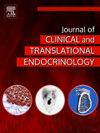Simple prediction model for vitamin D deficiency in women with osteoporosis or risk factors for osteoporosis in Thailand
IF 3.3
Q1 ENDOCRINOLOGY & METABOLISM
Journal of Clinical and Translational Endocrinology
Pub Date : 2024-12-01
DOI:10.1016/j.jcte.2024.100377
引用次数: 0
Abstract
Introduction
In Thailand, the assessment of vitamin D status by measuring 25-hydroxyvitamin D[25(OH)D] levels in individuals at risk for osteoporosis is constrained by limited facilities and high costs. This study aimed to create a clinical model for predicting vitamin D deficiency in women with osteoporosis or risk factors for osteoporosis.
Materials and Methods
This was a cross-sectional study of 490 women. All participants had 25(OH)D levels measured. A questionnaire was used to assess factors related to vitamin D status. Vitamin D deficiency was defined as 25(OH)D levels < 30 ng/mL. Logistic regression analyses were conducted to investigate predictors of vitamin D deficiency. In the model, odds ratios (ORs) were converted into simple scores. The optimal cutoff for women at a high risk of vitamin D deficiency was established. Internal validation was assessed using a Bootstrap.
Results
Sixty percent had vitamin D deficiency. The final model for predicting vitamin D deficiency consisted of a body mass index ≥ 25 kg/m2 (OR:1.15), lack of exercise (OR:1.59), exercise 1–2 times/week (OR:1.40), sunlight exposure < 15 min/day (OR:1.70), no vitamin D supplementation (OR:8.76), and vitamin D supplementation of 1–20,000 IU/week (OR:2.31). The area under the curve was 0.747. At a cutoff of 6.6 in total risk score (range 4–13.6), the model predicted vitamin D deficiency with a sensitivity of 71.9 % and a specificity of 65.3 %. The internal validation by Bootstrap revealed a ROC of 0.737.
Conclusions
In women at risk of osteoporosis, a simple risk score can identify individuals with a high risk of vitamin D deficiency. These women could benefit from vitamin D supplementation without requiring 25(OH)D measurements.
泰国骨质疏松症妇女维生素D缺乏或骨质疏松症危险因素的简单预测模型。
在泰国,由于设备有限和费用高昂,通过测量有骨质疏松风险个体的25-羟基维生素D[25(OH)D]水平来评估维生素D状态受到限制。本研究旨在建立一种临床模型来预测骨质疏松症妇女维生素D缺乏症或骨质疏松症的危险因素。材料和方法:这是一项涉及490名女性的横断面研究。所有参与者都测量了25(OH)D水平。一份调查问卷用于评估与维生素D状况相关的因素。维生素D缺乏症被定义为25(OH)D水平结果:60%的人缺乏维生素D。预测维生素D缺乏的最终模型包括体重指数≥25 kg/m2 (OR:1.15)、缺乏运动(OR:1.59)、每周运动1-2次(OR:1.40)、阳光照射。结论:在有骨质疏松症风险的女性中,简单的风险评分可以识别出维生素D缺乏的高风险个体。这些妇女可以从补充维生素D中获益,而不需要测量25(OH)D。
本文章由计算机程序翻译,如有差异,请以英文原文为准。
求助全文
约1分钟内获得全文
求助全文
来源期刊

Journal of Clinical and Translational Endocrinology
ENDOCRINOLOGY & METABOLISM-
CiteScore
6.10
自引率
0.00%
发文量
24
审稿时长
16 weeks
 求助内容:
求助内容: 应助结果提醒方式:
应助结果提醒方式:


